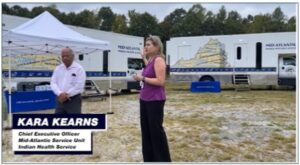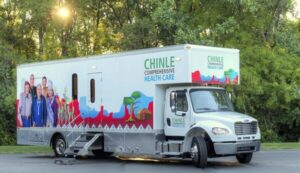In 2023, the U.S. Census Bureau reported that 2.7 million people identified solely as American Indian or Alaska Native, while 6.3 million identified as Native American or in combination with one or more other races.
The Native American population has experienced notable growth in recent years. According to Indian Country Today (ICT) News, the U.S. Census Bureau reported an 86.5% increase in individuals identifying as American Indian and Alaska Native, alone or in combination with other races, between 2010 and 2020. This sharp rise nearly doubled the population in just a decade.

Today, though still considered an underserved population, one of the most significant improvements in bridging the gap in healthcare access for Native American populations is the use of Mobile Health Clinics. Limited transportation, lack of insurance, or other barriers impede many Native Americans, who often live in remote, rural tribal communities, from reaching traditional hospitals or clinics.
In the context of shortages in health resources, tribal lands are considered federally designated Frontier and Remote (FAR) areas due to geographic remoteness and low population density, which restricts access to essential services. Any area with a population density of less than or equal to six people per square mile is often at the most remote end of a population continuum. Shortages in rural medical care are further exemplified by traditional brick-and-mortar healthcare facilities being financially unsustainable in these remote areas, as more than thirty percent of rural hospitals have either closed or are at risk of closing in recent years.
IHS Service Units are geographically defined regions within the Indian Health Service (IHS) system, created to deliver effective, high-quality health care to American Indian and Alaska Native communities. Each service unit may include one or multiple federally recognized tribes and is designed to ensure comprehensive coverage within IHS’s funded areas, including those considered “on or near” reservations. Though no geographic location can be assigned to multiple service units.
The primary goal of these service units is to establish an efficient structure for delivering health services. When new tribes gain federal recognition, they are integrated into existing service units or placed within newly created ones, ensuring all tribes receive appropriate care.


Native American and Alaskan populations in the United States are numerous and socially diverse, with differing cultures, customs, and characteristics. However, there are historical similarities among the Indigenous nations and tribes, including racism and dissociation, which can increase negative societal outcomes such as isolation, high unemployment, and social biases, which, in turn, may foster harmful behaviors such as alcoholism, drug dependence, and suicide. These social stigmas, in turn, can result in harmful individual outcomes. Studies show that Native Americans have higher morbidity and mortality rates of diabetes, cardiovascular disease, certain forms of cancer, dental disease, and behavioral health issues.
The mobile clinics in the Mid-Atlantic and other Service Units provide various services, including general health screenings, vaccines, checking vital signs, oral health services, and mental health counseling and referrals. IHS Nashville Area Director Beverly Cotton states, “The service unit provides an important link between the community and primary, dental, and behavioral health care by increasing health care accessibility, especially for rural areas.”

 dental chair. The unit offers all aspects of dental care, including X-ray exams, teledentistry services, and an on-site lab for processing and repairing dental prosthetics.
dental chair. The unit offers all aspects of dental care, including X-ray exams, teledentistry services, and an on-site lab for processing and repairing dental prosthetics. Delivering healthcare services, especially in areas where access to traditional healthcare facilities might be limited, is a significant component of their mission. The mobile clinic offers a range of healthcare services, including primary and diagnostic care.
Delivering healthcare services, especially in areas where access to traditional healthcare facilities might be limited, is a significant component of their mission. The mobile clinic offers a range of healthcare services, including primary and diagnostic care.Mobile health programs are on the rise across the United States in serving Native Americans. They are vital in supporting Native American tribes by expanding access to care in remote areas. These clinics deliver essential services, such as dental care, women’s health, screenings, vaccinations, behavioral health, and substance abuse treatment, to communities that often face significant barriers to traditional healthcare. They also promote health literacy and help establish consistent medical care for individuals with limited access.
Here’s how mobile health clinics make an impact:
Mobile health clinics bring healthcare directly to rural and remote tribal communities, where brick-and-mortar facilities may be scarce. By offering preventive care, chronic disease management, and regular screenings, these clinics help improve overall health outcomes.
Mobile clinics reduce patients’ travel time and expenses while maximizing healthcare providers’ reach and efficiency. They offer a flexible, scalable solution that meets people where they are.
Sources Include:
Mobile Medical Unit Mobile Dental Van Mammogram Mobile Mobile Simulation Lab Blood Mobiles Mobile Medical Labs
Resource Center
Entire contents ©1996-2025 LifeLine Mobile, Inc. • All rights reserved • LifeLineMobile® is a registered trademark